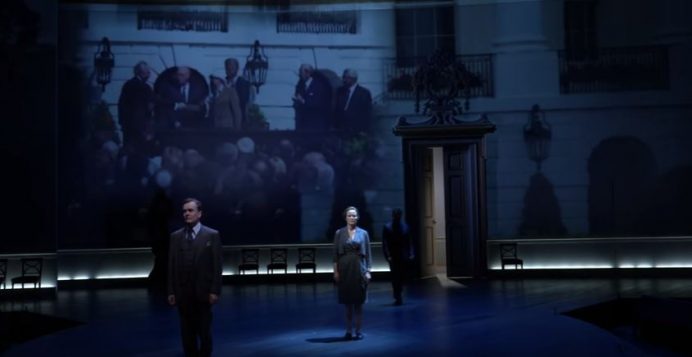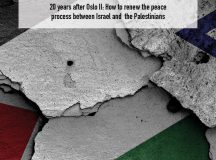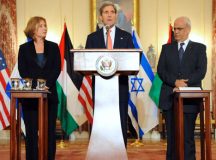To mark the Tony Award winning play Oslo opening in London this September, based on the Oslo Peace Process, Einat Wilf analyses its accuracy in terms of its portrayal of the actors involved and the negotiations that took place. Wilf argues that Oslo is a thinly disguised variation on the theme ‘The White Man’s Burden,’ in which the Israelis and Palestinians are wrongly represented as primitive tribes who require civilised, Western negotiators to end their conflict, as opposed to both peoples being sovereign agents who need to determine their future for themselves and by themselves.
The play Oslo which opens at the Lyttleton Theatre in London on 5 September, is ostensibly about peace. In reality, it is a thinly disguised variation on the theme of ‘The White Man’s Burden’. The play is not – as one might expect – about how Israelis and Palestinians came together in 1993 to forge an agreement intended to bring about peace over time. Rather, it is about how altruistic Norwegians were able to civilise, albeit only partially, two primitive warring tribes, that until the white man’s (and woman’s) saintly intervention, knew no better than to engage in senseless violence.
Multiple elements convey this message throughout the play: Israeli and Palestinian characters are portrayed as cartoonish stereotypes that emphasize their ‘otherness’; whatever issues underlie their conflict are mocked and dismissed; the violence between the sides is a decontextualised endless cycle with no reason; and the Norwegian diplomats – true to Norway’s historic standing as the world’s top exporter of Christian missionaries per capita – are on a mission from God. The bottom line, by the play’s end, is that ‘the white man and woman’ tried their best, but there is a limit to what one can do with brutes.
The crass stereotypes of Israeli and Palestinian characters were my first clue that something was deeply wrong with the play. When I recently saw Oslo in New York at the Lincoln Center Theater, being a member of one of the warring tribes, I was shocked by its portrayal of people with whom I worked closely and knew well – Yossi Beilin, Uri Savir, Yair Hirschfeld and Ron Pundak. Beilin and Savir are presented as foul mouthed Israeli thugs – in what is about the furthest possible characterisation from who they are. The weighty and serious Hirschfeld and Pundak are portrayed as early Woody-Allen type bumbling Jews. It is as if in coming to represent Israeli Jews, the only two possibilities the director could imagine were very Jewishey Jews or Israeli thugs. Granted, a more accurate portrayal of all four of them as the bureaucratic and academic nerds that they are could have robbed the play of some of its dramatic appeal, but one wonders if there shouldn’t be a way to satisfy dramatic needs without resorting to demeaning shortcuts. (It is perhaps no accident that the one Israeli who is portrayed as he is, is Shimon Peres, who is far too well known to mess around with.)
The Arab characters, Ahmed Qurie and Hassan Asfour, were subjected to a similar stereotypical portrayal. They are loud mouthed, uncouth, with Asfour in particular, presented as the caricature of an Arab communist – with every one of his utterings a ridiculous speech. Asfour’s portrayal serves two purposes; to present him as an Arab ‘other,’ and to mock his communism, the ideology most inimical to any Christian missionary. Not for a moment is the possibility entertained that communism played an important and legitimate role in the forging of a post-colonial Arab identity.
In general, the possibility that serious ideas, interests and ideologies underlie the conflict, is noticeably absent from the play. To judge from the script, Israelis and Palestinians don’t have any real issues that explain the tenacity of the conflict. Instead it offers us a cauldron in which words like ‘terrorism,’ ‘colonialism,’ ‘gassed grandparents,’ and ‘Jerusalem’ arouse emotions, for no apparent reason. Violence is senseless and cyclical; whenever violent events off-stage are referred to in the play, it is in a monotonous recital of ‘A murdered B,’ ‘B retaliated,’ ‘A rioted’.
This disregard for the issues that actually underpin the conflict is displayed in a telling scene in which Savir and Qurie, upon their first negotiation meeting, tell each other how their respective people’s views the other (‘terrorists’, ‘murderers’). Once each is done with his lurid expose, the character of Savir sums this exchange as, ‘Well, now that we’ve both swung our dicks.’ To the writer, who put these words in the character Savir’s mouth, the conflict between Israelis and Palestinians is essentially a form of ‘swinging dicks’ – the very image of a primitive tribal ritual.
And who saves these primitive tribes, engaged in a contest of ‘swinging dicks,’ from their endless and senseless cycle of violence? The ‘white man’ of-course, who, in this play, is embodied in the form of the two married Norwegian diplomats, Tarje Larsen and Mona Juul, an almost Maria-like figure.
The civilising mission of the diplomats is expressed in a scene in which Larsen and Juul undertake to calm down the savages. In the only expression of actual violence on the stage, which is, true to stereotypes, by an Arab, Qurie nearly hits Larsen. His violent outburst, well into the play, underscores that despite the civilising process he has undergone so far, and the grand Norwegian palace exterior, the savage remains underneath.
The following scene encapsulates the condescending undertone of the entire play. Like a young chided boy, Qurie appeals to Juul to make amends for his behaviour. In response, she motions to him, as if he were a five-year old, to make friends and go for a walk with his Israeli negotiating partner, Savir. Qurie tries to wiggle out of this unpleasant chore, but like a stern mother, Juul will have none of it. So, chastised, the two infants Qurie and Savir go for a walk in the woods under the watchful eye of the Norwegian diplomats. As Savir and Qurie begin to engage in friendly conversation, Larsen and Juul look on pleased and proud, as if they were just able to happily resolve a playground crisis between two annoyingly rowdy children.
This scene also caters to one of the central premises of the Norwegian civilising mission, which is, that by forging personal relations and creating ‘bonds of trust’ between negotiators, peace can be made and ancient enmities overcome. During their conversation in the woods, Savir and Qurie share a smoke and learn that their daughters have the same name – Maya. This is a pregnant moment. The audience learns that both Israeli and Palestinian men can be fathers! That both can have daughters named Maya! Hey, so these brown people are indeed similar! Which means that what they’re fighting over can’t be serious! And peace is just around the corner! Hurrah! So, all that is needed for making peace between Jews and Arabs, Israelis and Palestinians, is for them to just get to know each other and see that their differences don’t amount to a hill of beans in this world. Indeed, given that Israelis and Palestinians don’t have any real substantive issues that merit serious consideration, the key to forging an agreement between them, according to Larsen, is the application of ‘constructive ambiguity’ – essentially, diplomatic high speak for fudging the issues. And the issues can be fudged, since they aren’t that important anyway.
But everything is excused for the diplomats, because their motivations are altruistic and entirely noble. In a most telling interaction well into the play, one of the Israeli negotiators turns to Juul to ask her, ‘Why are you doing this?’ He wants to know why a Norwegian diplomat has decided to devote her time to an issue that does not directly affect her. It is a wholly legitimate and reasonable question from someone who actually has a stake in the issue. Especially given that he, unlike her, would not be able to run away to the comforts of northern Europe when everything later will literally blow up in his face.
The answer of Juul to this straightforward question? ‘If you have to ask, you wouldn’t understand my answer.’ Herein lies the message of the entire play: the warring tribes are incapable of fathoming the spiritual mission that guides the Norwegian diplomats. All that the tribesman can comprehend is people contending themselves with their immediate earthly concern. They cannot understand why the ‘white man’ would spend time and effort making peace between warring tribes living thousands of miles away. The tribesmen cannot grasp that the Norwegian is animated by a higher spirit and a noble goal. In fact, the ‘white man and woman’ are so noble that they can’t even bother to communicate their higher spiritual mission to the lowly tribesman – as he ‘wouldn’t understand’. Indeed, the ‘white man’ is so willing to sacrifice himself for the good of humanity, that when it becomes clear that Juul and Larsen would not be seated at the honorary tables following the signing of the accords, the saintly Juul/Maria reminds Larsen that ‘it is not about us’.
Alas, when, by the end of the play, it becomes clear that the warring tribes have descended yet again to their endless cycle of senseless violence, Larsen turns to the audience to assess his handiwork. One would think, that given the time that has passed and the spectacular failure of it all, the diplomat would have to answer for the complete collapse of his two key premises – that constructive ambiguity contributes to peace-making, and that personal relations can overcome deep seated enmities. But no, rather than admit that constructive ambiguity has been a disaster, and that personal relations, while nice, cannot replace the deep forces that drive the conflict, the character of Larsen invokes the audience to ‘not look at where we are,’ but to ‘see how far we have come’ (how far, really?). He might as well have asked the audience to ‘not judge the tribes by the fact that they still can’t play cricket, but celebrate the fact that they can hold a knife and fork’.
Oslo might be a well written play that keeps up the dramatic pace of what is supposedly a serious and heavy issue. But for those who actually care about understanding, and perhaps one day, resolving the conflict, it is worth keeping in mind that the conflict between Israelis and Palestinians, between Jews and Arabs in the Middle East, rests on serious issues that go to the core of matters of each other’s sense of justice, history, and identity. It also so happens that these two warring tribes are engaged in a conflict no more violent (and in fact a whole lot less) than other conflicts raging around the world (and certainly much less violent than those conducted by ‘white men’ over the centuries); that moving towards peace requires constructive specificity that directly and clearly addresses the most contentious issues; and that personal relations among negotiators make for a nice atmosphere, but can’t replace the larger forces that drive the conflict. Finally, and most important to bear in mind, is that Israelis, Palestinians, and Arabs are sovereign agents who need to determine their future for themselves and by themselves. This means that no-one – no matter how spiritual and saintly – can do it for them, even if he or she believe that resolving this specific conflict is the burden they have been charged with by God. They have not.






































The survival of the “White Man’s Burden” concept as a Western mode of dealing with non-Western peoples shows the de facto limits of the baleful influence of Edward Said’s “Orientalism”. This mindset is deeply ingrained in the European psyche and fed not only the colonial vision of both Britain and France, both of whom eventually framed their exploitation of others as part of some nobler and grander if ill-defined and vague “mission civilisatrice.” Not surprisingly, that mindset was the foundation of the post-WWI compromise between taking colonies from the defeated nations and allowing for immediate self-determination of non-Eurpoean peoples: the system of mandates created by the League of Nations (which today exist as “trusteeships”). The three types of mandates were created to distinguish between the amount of tutelage the populations designated for eventual independence required of their Eurpoean betters before in fact being set free. Of course, no standards were set nor any mechanism agreed upon to allow for the eventual determination. That the play “Oslo” carries this conception of European superiority forward shows how little of substance has changed. I suppose it is some small consolation that the Israelis are not lumped in as “Whites” for purposes of this narcissistic exercise, avoiding the linchpin of what passes for the Leftist critique of Jews returning to their historical homeland, that they are in fact “settler colonialists” acting in some unspecifiable manner on behalf of some unnamable “mother” country.
On the issue of ambiguity, constructive or specific, there is a school of throught that holds as a necessary condition to an end of conflict that both sides agree on a “convenient fiction” as to the causes. This is a political requirement that has nothing necessarily to do with the actual history, but it is a device that allows the societies in question to move forward. Over time, when the questions are less raw, the actual history can be recovered but in the interim the fiction serves it larger purposes even if there are injustices in it. So, for instance, the US eventually rationalized the Civil War as a fight in which both sides held noble aims, leading to the “Lost Cause” concept that not only wrote out slavery as a motivating factor of secession (which it clearly was, one need only read the various declarations of secession by the Confederate states lest there be any real doubt) but also permitted the re-subjugation of most blacks in the South through Jim Crow laws. The Civil Rights movement, nearly one hundred years after the Civil War, and today’s white supremacist and New-Nazi movements show the inevitable breakdown of this particular “convenient fiction.”
In post-WWII France, de Gaulle crafted the “convenient fiction” that most Frenchmen were part of the Resistance – when everyone at the time knew this was false. That the issue remains raw is confirmed by the reaction to President Macron’s statements of France’s responsibility for what happened to Jews during Vichy which was to assert that Vichy was not France which could not be held responsible. The Leftist Melanchon was clear in his condemnation of Macron on this point.
The “convenient fiction” advanced by the EU, of course, is that WWI and II were the product of too much nationalism to which the EU was the correct answer. That fiction explains, in some small part, the EU’s generally negative view of Israel which is a successful and proud nationstate, thereby falsifying the EU fiction. Also, under the stress of Muslim immigration, difficult economic issues, the “convenient fiction” itself is coming under stress.
As applied to the Israeli-Arab conflict, the “convenient fiction” could take the following form. After the Allied victory in WWI, the Arabs have been restored as rulers over 99.75% of those territories. Israel is the historical homeland of the Jewish people, or, as the Qur’an has it, of the Children of Israel, to whom Allah himself promised the land in perpetuity. Therefore, this exceptional promise by the Jewish and Muslim version of the deity allows for carving out an exception to dar-al-Islam and confirms the rights of the Jewish people to the land of Israel with whom its Arab neighbors shall live in peace. There at least is a “constructive fiction” that is worth trying.